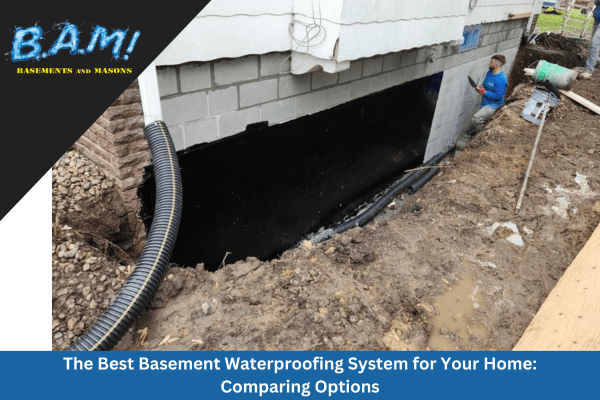Unknown Facts About Best Basement Waterproofing
Table of ContentsIndicators on Best Basement Waterproofing You Need To KnowBest Basement Waterproofing Fundamentals ExplainedThe Greatest Guide To Best Basement WaterproofingBest Basement Waterproofing Things To Know Before You BuyThings about Best Basement Waterproofing
AdvantaClean's skilled specialists and technicians will certainly locate the water source. If wall or piece cracks are present, we will certainly infuse polyurethane and epoxies right into the fractures and secure the concession, avoiding additional dampness from entering.Appropriate grading around the home to guide moisture far from the framework. Setting up, fixing, or cleaning seamless gutters and downspouts. Inside or external waterproofing with filler, sealer, and/or water-proof paint. Installing basement ventilation systems, conditioning systems, or cellar dehumidifier systems to obtain water out of your basement. Choosing AdvantaClean's cellar waterproofing solutions is an effective way to treat dampness and prevent mold from compromising the structure of your home and the health and wellness of your family members.
If there's condensation on the outside of the aluminum foil, you have high moisture in your basement. If the foil has condensation on the within surface (next to the wall surface), the dirt around your home might be normally damp from a high water table or inadequate soil drainage.
You can waterproof just your interior walls, which may fix the issue. Once they dry out, they adhere permanently to concrete and masonry wall surfaces.
Some Of Best Basement Waterproofing
Concrete water resistant finishings can not be used to previously repainted surface areas; check the label. Understood as densifiers, they are ideal just for walls that haven't been repainted or sealed.
Yet you comb, roll, or spray it on a lot even more thickly one gallon covers simply 75 square feet, not the 300 square feet regular with basic paint. Water resistant paint is fine for do it yourself application. You can apply it over repainted surfaces, and paint over it once it's healed (one gallon costs $37).
It can cost $10,000 to $15,000, depending on the job needed. Exterior waterproofing includes excavating throughout the residence fully deepness of the foundation walls, then setting up a waterproof layer or membrane covered by drain panels. The panels supply a simple path for water to flow to an exterior French drain at the end of your foundation.
Little Known Facts About Best Basement Waterproofing.
We've all been captured in a tornado without any umbrella or raincoat. And it's always a dish for disaster: whatever's wet, your coiffure is destroyed, and things are getting moldy. A basement without waterproofing is kind of like that. Minus the wrecked hairstyle part. Your basement does not desire to experience a rainstorm without appropriate defense simply as high as you don't wish to.

Exterior waterproofing is a waterproofing method that involves securing your home from the exterior. It's type of like a moat around a castle. It includes digging a trench around your entire house to the structure (about Our site 8 to 10 feet down). The structure walls are after that cleaned up, sealed, and covered with a waterproof membrane layer or sealant.

Some Known Details About Best Basement Waterproofing
It's a more engaged process that calls for excavating up your lawn, which is pricey and lengthy. Outside waterproofing includes eliminating every little thing surrounding your house, including decks, driveways, sidewalks, landscaping, air conditioning units, decks, and so on. If any one of the job was done inaccurately and water is still entering your cellar, there isn't much you can do to remedy or fix it.
Inside cellar waterproofing includes waterproofing from the inside. Any kind of water that leakages into your basement is rerouted before it touches your flooring.
It's an effective technique to waterproof your basement. The disadvantage of indoor cellar waterproofing mostly concerns the installation process. This technique calls for stored items, furnishings, and built-in shelving or cabinets to be relocated from touching the cellar walls. And during installment, your cellar can't be made use of. The largest distinction between both methods is this: Exterior waterproofing is a preventative solution and interior waterproofing is a restorative option.
The Ultimate Guide To Best Basement Waterproofing
To conclude, outside and interior cellar waterproofing are useful link both efficient approaches of shielding your home from water damage. Outside waterproofing develops a barrier that stops water from entering your home, while indoor waterproofing redirects water that does enter your home. And it is necessary to note that outside waterproofing is a costly and turbulent setup process when compared Recommended Reading to indoor waterproofing.
Whichever method you pick, make certain you pick a dependable and credible service provider for the job. Both techniques call for knowledgeable workers to handle the job. If you have any type of questions concerning cellar waterproofing, please get to out to us. And if you remain in our service location and have water in your cellar, call us for a complimentary, no-obligation home examination.
You can fill in our kind here. Best Basement Waterproofing, start a conversation in the lower right-hand corner, or call us at 1-800-827-0702